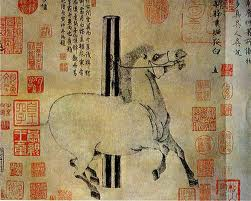Night - Shining White

The setting sun is like a fireball in the sky. There is a gentle breeze and the soft undulating hills of ancient China, look like a green carpet has been spread over them. Suddenly, as if out of nowhere, a stunning, pure white steed appears like an apparition on the horizon. As the majestic horse canters freely every muscle in his body ripples and his beautiful mane blows in the wind. This spirited steed is 'Night – Shining White'. He is the favourite imperial stallion of Emperor Xuanzong, of the Tang dynasty. There is something more than the sheer physical beauty of this animal; it is his spirit, which epitomizes the Chinese myth about imported ‘celestial steeds' that ‘sweat blood’ are really dragons in disguise. It is the eighth century, and Tang China is one of the greatest empires in the medieval world. Emperor Xuanzong, is referred to as the ‘brilliant monarch ‘and his reign is rightfully ranked as the classical period of Chinese art and literature. Han

